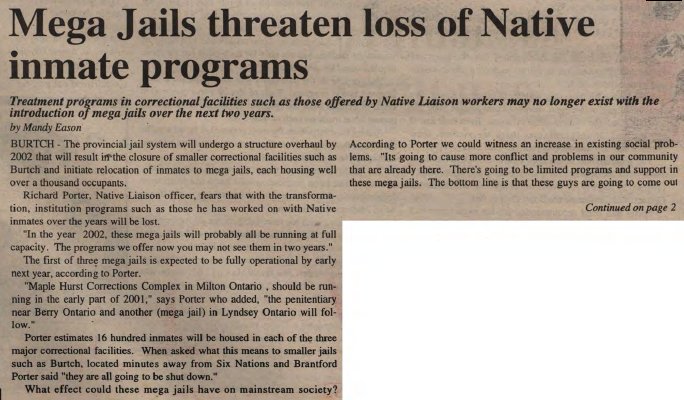"Mega Jails threaten loss of Native inmate programs"
- Publication
- Tekawennake News (Ohsweken, Ontario), 15 Mar 2000, pp.1-3
- Full Text
- Mega Jails threaten loss of Native inmate programsTreatment programs in correctional facilities such as those offered by Native Liaison workers, may no longer exist with the introduction of mega jails over the next two years.
by Mandy Eason
BURTCH - The provincial jail system will undergo a structure overhaul by 2002 that will result in the closure of smaller correctional facilities such as Burtch and initiate relocation of inmates to mega jails, each housing well over a thousand occupants.
Richard Porter, Native Liaison officer, fears that with the transformation, institution programs such as those he has worked on with Native inmates over the years will be lost.
"In the year 2002, these mega jails will probably all be running at full capacity. The programs we offer now you may not see them in two years."
The first of mega jails is expected to be fully operational by early next year, according to Porter.
"Maple Hurst Corrections Complex in Milton Ontario, should be running in the early part of 2001," says Porter who added, "the penitentiary near Berry Ontario and another (mega jail) in Lyndsey Ontario will follow."
Porter estimates 16 hundred inmates will be housed in each of the three major correctional facilities. When asked what this means to smaller jails such as Burtch, located minutes away from Six Nations and Brantford Porter said "they are all going to be shut down."
What effect could these mega jails have on mainstream society?
According to Porter we could witness an increase in existing social problems. "Its going to cause more conflict and problems in our community that are already there. There's going to be limited programs and support in these mega jails. The bottom line is that these guys are going to come out
(Continued on page 2)
Mega Jails threaten loss of Native inmate programsTreatment programs in correctional facilities such as those offered by Native Liaison workers may no longer exist with the introduction of mega jails over the next two years.
by Mandy Eason
(Continued from front page)
worse than when the went in."Currently programs offered to Aboriginal inmates at correctional facilities such as Burtch, involve a healing of the entire person.
Spiritual teachings are incorporated into the programs Porter and other facilitators deliver including sweat lodges and lectures from elders.
"We work with them on a number of different issues. We try to help build self-esteem, develop a post-release plan, we also talk about the victims of the offenses. Even in D and D (Drunk and Driving) offenses there are victims, their families who are without them suffer," said Porter.
The program was initiated by Pine Tree Native Centre in 1991, upon the approval of a six month grant to construct a program to address the needs of Native inmates in Burtch Correctional Centre and the Brant County Jail.
Porter had been recommended for his experience as a volunteer in the institutions as well as someone who had a first hand understanding of what it was like to be an Aboriginal person on the outs with the law.
His life experience gives testimonial to the healing properties of Native spirituality and the opportunity to a clean start.
Tony Bomberry a co-worker of Porter also understands what it is like to have a hard life.
Wanting to give back to society, Bomberry pursued a life in social services.
"I grew up in the Children's Aid Society. Then I went on to take Social Work in school," said Bomberry.
Of the work he does now within the corrections system he describes it as a challenge he enjoys.
"We are front line workers at a job that is different everyday." It definitely keeps things interesting."
During Tekawennake's interviews with Burtch Correctional Facility inmates, one could observe a sense of respect the inmates had not only for each other but for those who delivered the programs.
The purpose of the interviews was to explore the Native Inmate Liaison program. Each of the 20 participants were asked to explain what the program has taught them and the impact it has made on each of their lives.
Among their responses the most commonly heard was the revelation that they did not have an understanding of their heritage prior to entering the jail system.
The youngest inmate in the group was 18 year-old Terry Murray. "I've been bounced around back-and-forth from foster home to foster home. I never knew what it was like to be an Aboriginal or to belong."
Murray along with his three brothers are all incarcerated simultaneously. One of his brothers James Maurer, two years his senior, is also serving his term at Burtch.
"I didn't get all of my letters in for my parole hearing. They were due today, the tenth (March). My mom was suppose to write a letter but I don't really blame her. She's got a lot to deal with," says Maurer.
Aside from all four sons in jail James say his mother's husband is undergoing a 28-day treatment for alcohol abuse.
"She has to worry about all of us," said Maurer.
When asked to explain what the program room means to him personally? "It means an hour or two of freedom. Away from that side of the door," said Maurer pointing to the door separating us from the rest of the jail.
The story the brothers told was not uncommon amongst those in the group. In fact it reflected a number of the other responses.
As Murray mentioned it was his first exposure to his culture, as it was for older inmates such as John Rebelo. "This has given me a lot of culture. I was raised as a
(Continued on page 3)
Mega Jails threaten loss of Native inmate programsby Mandy Eason
(Continued from page 2)
Christian. It makes me feel like I belong to something and that's something I've missed for a long time."A Native from the United States, Rick Ayre, says he too found something in the group that he felt he had lost. "I was raised by my grandfather. When I moved to Ontario I got hooked into society and forgot all of my ways. I was alone, confused and now I have people to talk to. I feel a lot better."
Other inmates such as Andie Fuller attributes his ability to carry on in life to the support he found in the group.
"I've been incarcerated (at Burtch) since 1997 and I probably would have come unglued a long time ago but I wouldn't allow a place like this to break my spirit."
The group has given the men strength, a better understanding of who they are and what they want out of life. Inmates make the decision of their own free will to participate.
"Everyone of us wants to be here in this group. We want to learn. Being here together helps me realize who I am and what I'm a part of," said Chris Hill.
Porter has developed a bond with the men. He considers it to be an "honour and pleasure to support these guys. They give me the same honour and respect. Some of these guys stop at my house. There's 20 men in here and I respect everyone of these guys and I know they'll make if they want to."
It is obvious the men have found strength in the program's facilitators and in each other. However, when they do leave the facility is that enough to sustain them?
Angela Powless, a Native liaison worker who assists both male and female inmates says sometimes upon release the options are too overwhelming.
"In here they have the support. But when they get out of there (jail) all of their options are open and they may not have found the support they had in here."
Inmate William Cooper remains optimistic, "I'm praying for my brothers to go straight when they get out."
For some, good intentions are not enough to remain on the outside of prison walls. Burtch inmate Kord Hill realized exactly that when he was released.
"When I was back out (in society) I left everything I'd learned behind. I've been in and out of institutions all of my life. Then, I found out I wasn't alone. I turned myself in (to police authorities) and by doing that it made me realize that I wasn't ashamed of who I am."
The support programs offered are not limited to those serving sentences. An after care support circle for ex-inmates and their families based on sobriety and fellowship is also offered. The group meets weekly to share resources and re-enforce traditional teachings and values.
Professional assistance from community agencies and workshops help ex-inmates and their families deal with the negative influences. Topics dealt with include anger management literacy, healthy relationships, life skills, addictions, HIV/AIDS and diabetes education.
This is the second article in a series of stories exploring Native peoples experience in the justice system and the services offered.
- Creator
- Eason, Mandy, Author
- Media Type
- Text
- Newspaper
- Item Type
- Clippings
- Publisher
- Tekawennake News
- Place of Publication
- Six Nations of the Grand River, ON
- Date of Publication
- 15 Mar 2000
- Subject(s)
- Personal Name(s)
- Porter, Richard ; Bomberry, Tony ; Powless, Angela ; Fuller, Andie ; Ayre, Rick ; Hill, Chris ; Cooper, William ; Hill, Kord.
- Corporate Name(s)
- Maple Hurst Corrections Complex ; Pine Tree Native Centre ; Brant County Jail ; Children's Aid Society ; Burtch Correctional Centre.
- Local identifier
- SNPL004849v00d
- Language of Item
- English
- Geographic Coverage
-
-
Ontario, Canada
Latitude: 43.0501 Longitude: -80.26637
-
- Creative Commons licence
 [more details]
[more details]- Copyright Statement
- Public domain: Copyright has expired according to Canadian law. No restrictions on use.
- Copyright Date
- 2000
- Copyright Holder
- Tekawennake News
- Contact
- Six Nations Public LibraryEmail:info@snpl.ca
Website:
Agency street/mail address:1679 Chiefswood Rd
PO Box 149
Ohsweken, ON N0A 1M0
519-445-2954



